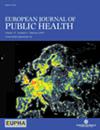Interventions for cold homes: a rapid review of the health impacts
IF 3.7
3区 医学
Q1 PUBLIC, ENVIRONMENTAL & OCCUPATIONAL HEALTH
引用次数: 0
Abstract
Background Cold homes are associated with an increased risk of adverse health outcomes for older people. To mitigate this risk, homes need to be heated to an appropriate temperature. This review aims to identify interventions designed to improve heating and temperatures within homes and summarize its impact on health, health service utilization and cost effectiveness. Methods A rapid review was conducted. Studies assessing the effects of structural, financial, or behavioural interventions designed to improve home temperatures of residents aged 18+ years were eligible. Searches were carried out in four databases. A search for grey literature, and backward and forward citation searching were performed. Data were summarized in a narrative synthesis and mapped using EPPI-Reviewer and EPPI-Mapper software. Results Eighteen studies reported across 19 publications were included. Structural interventions were associated with better mental health and quality of life, a reduction in health service utilization, and improvements in satisfaction with internal home temperature, social interactions and financial difficulties. The impact on physical health outcomes varied by age, gender and long-term conditions. Evidence about the impact of behavioural interventions was inconsistent. Conclusion Structural improvements to increase home temperatures may offer the potential to improve some aspects of health. However, the impact on physical health, including which groups are most likely to benefit, is unclear. Key gaps include the lack of evidence about the impact of financial interventions, and the impact of all types of interventions, on quality of life, mortality and costs.寒冷住宅干预措施:对健康影响的快速审查
背景 寒冷的家居环境会增加老年人出现不良健康后果的风险。为了降低这种风险,需要将住宅加热到适当的温度。本综述旨在确定旨在改善家庭供暖和温度的干预措施,并总结其对健康、医疗服务利用率和成本效益的影响。方法 进行快速综述。对旨在改善 18 岁以上居民家庭温度的结构、财务或行为干预效果进行评估的研究均符合条件。在四个数据库中进行了检索。此外,还进行了灰色文献检索以及前后引文检索。使用 EPPI-Reviewer 和 EPPI-Mapper 软件对数据进行了叙述性综合总结和映射。结果 纳入了 19 份出版物中报告的 18 项研究。结构性干预与改善心理健康和生活质量、减少医疗服务使用以及提高对家庭内部温度、社会交往和经济困难的满意度有关。对身体健康结果的影响因年龄、性别和长期病症而异。有关行为干预影响的证据并不一致。结论 改善结构以提高室内温度可能会改善某些方面的健康状况。然而,对身体健康的影响,包括哪些群体最有可能从中受益,尚不清楚。主要差距包括缺乏有关经济干预措施影响的证据,以及所有类型的干预措施对生活质量、死亡率和成本影响的证据。
本文章由计算机程序翻译,如有差异,请以英文原文为准。
求助全文
约1分钟内获得全文
求助全文
来源期刊

European Journal of Public Health
医学-公共卫生、环境卫生与职业卫生
CiteScore
5.60
自引率
2.30%
发文量
2039
审稿时长
3-8 weeks
期刊介绍:
The European Journal of Public Health (EJPH) is a multidisciplinary journal aimed at attracting contributions from epidemiology, health services research, health economics, social sciences, management sciences, ethics and law, environmental health sciences, and other disciplines of relevance to public health. The journal provides a forum for discussion and debate of current international public health issues, with a focus on the European Region. Bi-monthly issues contain peer-reviewed original articles, editorials, commentaries, book reviews, news, letters to the editor, announcements of events, and various other features.
 求助内容:
求助内容: 应助结果提醒方式:
应助结果提醒方式:


